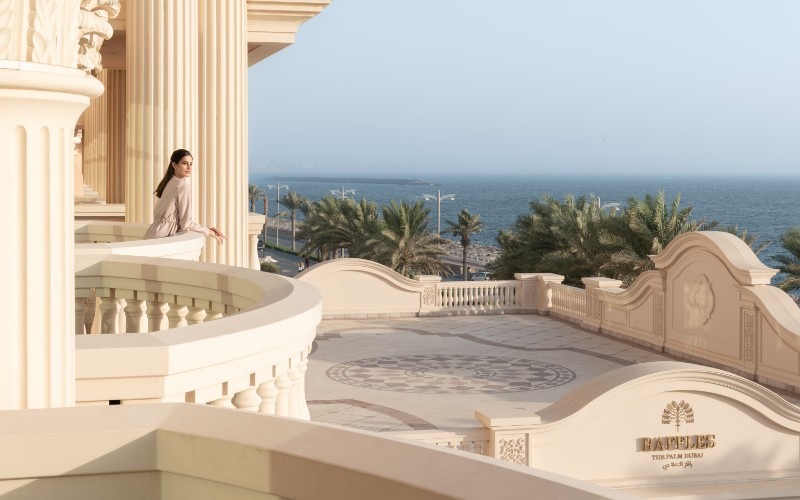Global luxury goods market accelerated after record 2022 and is set for further growth, despite slowing momentum on economic warning signs.

Bain & Company and Altagamma’s 2023 spring luxury study shows the personal luxury goods market is projected to grow 5-12% in 2023, following a record year in 2022, despite uncertain economic conditions. photo: @Raffles The Palm Dubai
The luxury goods market has experienced significant growth and is poised for further expansion, according to the latest report from Bain & Company, a leading global management consulting firm. The report, titled “Luxury Goods Worldwide Market Study – Spring 2023,” in collaboration with Altagamma, the Italian luxury goods manufacturers‘ industry association, provides valuable insights into the current state of the luxury industry and its future prospects.
In 2022, the personal luxury goods market reached a record market value of €345 billion, defying geopolitical tensions and macroeconomic uncertainty. The positive momentum continued into the first quarter of 2023, with a growth rate of 9-11% compared to the previous year. Several factors contributed to this growth, including the gradual decrease of hyperinflation, recovering consumer confidence in Europe, the reopening of the Chinese market, and the positive momentum in Japan and Southeast Asia, fueled by intraregional tourism.
However, the report acknowledges that there are nuances across different countries. In the United States, for instance, consumer caution around a potential recession has resulted in a slowdown in luxury spending. Despite having significant unspent savings, US consumers are refraining from spending due to economic uncertainties and the end of Covid relief funding. The top US customers are shifting their spending abroad as price differentials widen, and aspirational customers are reducing their spending. Nevertheless, statement pieces and new formal and occasion wear continue to drive purchases in the US luxury market.
Europe, on the other hand, has started the year strongly, with sustained performance in the first quarter. However, the region is expected to face challenges in the summer as the return of luxury shopping tourism from the US and the Middle East slows down. Nevertheless, Europe has witnessed the return of Chinese tourists in recent months, with a solid return expected later in the year.
In China, the luxury market saw growth in the first quarter and is expected to rise further in 2023, with some brands reaching their 2021 levels. The Asian market as a whole is undergoing a reshuffling, with destinations such as Hong Kong, Macau, and Southeast Asia experiencing significant growth. South Korea, however, is slowing down as locals redirect their spending to purchases abroad and travel retail, driven by inflows from Southeast Asia.
Japan stands out as a rising star in the luxury landscape. Local customers are maintaining their spending, and growth is also coming from inbound tourists, including the first signs of Chinese arrivals. Japan’s market value reached €24 billion in 2022.
The report emphasizes the importance of focusing on consumers holistically for luxury brands to succeed. It recommends balancing exposure across different geographies, offering a high value proposition with elevated entry clienteling and experientiality at scale, and emphasizing icons, timeless pieces, and statement items.
In terms of consumer behavior, the study highlights a “quest for elevation” across luxury categories. Customers are seeking iconic and uber-luxury pieces, valuing uniqueness over status and opting for “less but better” purchases. Watches, jewelry, and iconic bags are driving spending, while the shoe market is booming in Asia but slowing down in the Western world. Fragrances are experiencing growth, fueled by niche offerings and the recovery of duty-free, while makeup and skincare maintain positive trajectories.
In terms of distribution channels, experientiality and travel retail are gaining prominence, tapping into other luxury territories. Travel retail is finally recovering, thanks to the dynamism from Southeast Asia and Japan. Monobrand stores are also experiencing solid growth due to the appetite for in-store experiences. Direct retail, driven by tech-enabled consumers and omnichannel sales, is also on a solid growth path.
Looking ahead to 2023, the luxury market is projected to grow to between €360 and €380 billion, up from €345 billion in 2022. Bain & Company presents two scenarios: a positive scenario with sales growth between 9 and 12%, driven by China’s recovery, Europe, and the Americas, and a realistic scenario with sales growth between 5 and 8%, influenced by a slowdown in mature markets and a slower recovery in China. By 2030, the personal luxury goods market is expected to reach a value between €530 and €570 billion, approximately 2.5 times the size of the 2020 luxury market.
The report also highlights key challenges and opportunities for luxury brands. The industry will face regulatory pressures related to environmental, social, and governance (ESG) issues, requiring brands to focus on value chain decarbonization and reduce emissions. Additionally, generative AI will impact various aspects of the luxury value chain, revolutionizing distribution and creativity. Brands that can leverage new technologies and stay ahead of the curve will have a competitive advantage.
In conclusion, the luxury goods market has shown resilience and strong growth, despite geopolitical and economic uncertainties. With a focus on consumer-centric strategies, balanced exposure across regions, and an emphasis on iconic and unique offerings, luxury brands can navigate the evolving landscape and capitalize on future opportunities. However, challenges related to ESG and the adoption of new technologies should also be addressed to ensure sustainable growth in the long term.




